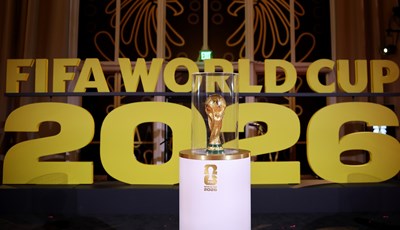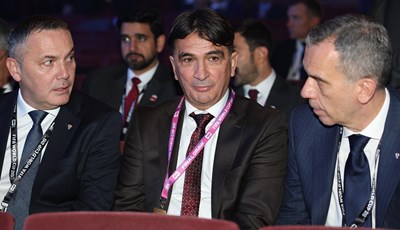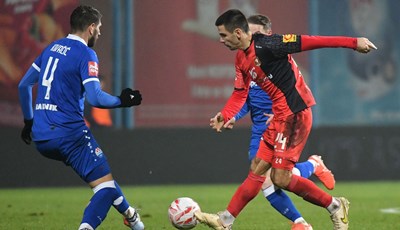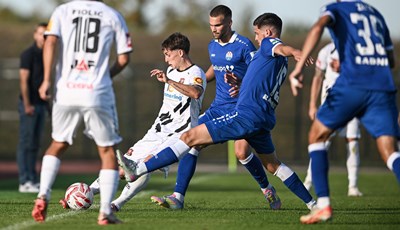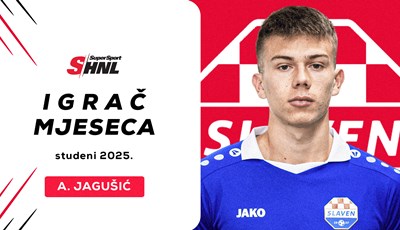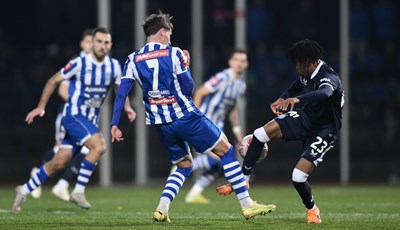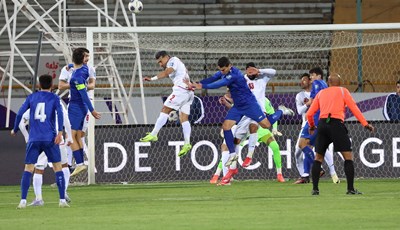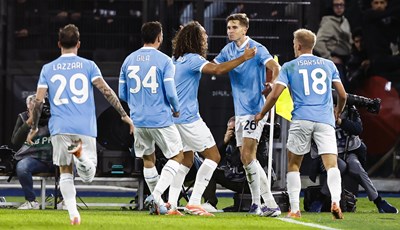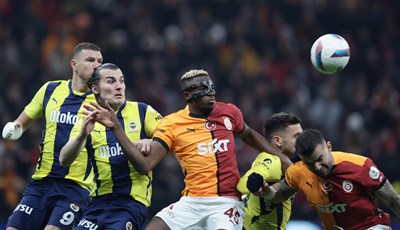MIDDLESBROUGH
The Middlesbrough crest has gone through four changes since the formation of the club. Initially, the badge was simply the town of Middlesbrough's crest with a red lion instead of a blue lion in order to fit in with the club's colours. Following the adoption of the white band on the shirts in 1973, only the red lion remained with the letters "M.F.C" underneath in red. This was further adapted following the reformation of the club in 1986 to a circular crest with the lion in the middle and the words "Middlesbrough Football Club 1986" around the circle in order to reflect this new era. In 2007, Middlesbrough changed their crest once again, this time with the lion inside a shield and the words "Middlesbrough Football Club 1876" underneath.[7] The Club stated that this was to reflect the club's long history and not just its post-liquidation status.
ASTON VILLA
A new crest was revealed on 2 May 2007, for the 2007–08 season and beyond. The new crest includes a star to represent the European Cup win in 1982, and has a light blue background behind Villa's 'lion rampant'. The traditional motto "Prepared" remains in the crest, and the name Aston Villa has been shortened to AVFC, FC having been omitted from the previous crest. Randy Lerner had got fans to help with the design of the crest.[9] The three kits that carry the new crest were unveiled on 17 July 2007, in The Mailbox, Birmingham.[28]
CHELSEA
Since the club's foundation, Chelsea have had four main crests, though all underwent minor variations. In 1905, Chelsea adopted as their first crest the image of a Chelsea pensioner, which obviously contributed to the "pensioner" nickname, and remained for the next half-century, though it never appeared on the shirts. As part of Ted Drake's modernisation of the club from 1952 onwards, he insisted that the pensioner badge be removed from the match day programme in order to change the club's image and that a new crest be adopted.[26] As a stop-gap, a temporary emblem comprising simply the initials C.F.C. was adopted for one year. In 1953, Chelsea's crest was changed to an upright blue lion looking backwards and holding a staff, which was to endure for the next three decades.
This crest was based on elements in the coat of arms of the Metropolitan Borough of Chelsea[27] with the "lion rampant regardant" taken from the arms of then club president Viscount Chelsea and the staff from the Abbots of Westminster, former Lords of the Manor of Chelsea. It also featured three red roses, to represent England, and two footballs. This was the first club badge to appear on shirts, since the policy of putting the crest on the shirts was only adopted in the early 1960s.[26]
In 1986, with new owners now at the club, Chelsea's crest was changed again as part of another attempt to modernise and to capitalise on new marketing opportunities.[26] The new badge featured a more naturalistic non-heraldic lion, yellow and not blue, standing over the C.F.C. initials. It lasted for the next 19 years, with some modifications such as the use of different colours. With new ownership, and the club's centenary approaching, combined with demands from fans for the club's traditional badge to be restored, it was decided that the crest should be changed again in 2004. The new crest was officially adopted for the start of the 2005–06 season and marks a return to the older design of the blue heraldic lion holding a staff.[4] As with previous crests, this one has appeared in various colours, including white and gold.
SUNDERLAND
In 2000 following a poll on the official Sunderland A.F.C. website, Sunderland confirmed the football club's traditional nickname of "The Black Cats".
There is a long historical link between Black Cats and Sunderland; including the "Black Cat Battery", a battery gun based on the River Wear, according to Sunderland A.F.C.. This link is reinforced by folklore in which the black cat is said to bring luck.
HULL CITY
Hull City did not wear a crest on their team shirt until 1947. This crest depicted a tiger's head in a yellow-shaded badge, which was worn up until 1955, when it was changed to just the tiger's head. This was worn for four years, when the shirt again featured no emblem. Then, in 1971, the club returned to showing the tiger's head on the shirt. This was used for four years, until the club initials 'HCAFC' were shown for five years. After this, a logo with the tiger's head with the clubs name underneath was used from 1980 until 1998. The next logo, which is currently used by the club, features the tiger's head in an amber shield which shows the clubs name, along with the clubs nickname, The Tigers.[28]
LIVERPOOL
The current Liverpool badge is based around the traditional liver bird, which is placed inside a shield. Above the shield is a representation of the Shankly Gates bearing the title of club's famous anthem, "You'll Never Walk Alone". The twin flames at either side are symbolic of the Hillsborough memorial, where an eternal flame burns outside Anfield, in memory of those who died in the disaster.[37]
TOTTENHAM SPURS
Since the 1901 FA Cup final the Tottenham Hotspur crest has featured a cockerel. Harry Hotspur (from whom the club is said to take its name) was famed for his riding spurs and fighting cocks were fitted with spurs which can be seen in the crests.[32] In 1909 a former player named William James Scott made a bronze cast of a cockerel standing on a football to be placed on top of the West Stand and since then the cockerel and ball have been the major part of the club's identity.[33]
Between 1956 and 2006 the Spurs used a coat of arms featuring a number of landmarks and associations linked to local area. The lions flanking the shield came from the Northumberland family's arms. They owned large areas of Tottenham and Sir Henry Percy (Harry Hotspur) was a family member. The castle alludes to Bruce Castle located 400 yards from the ground and which now houses a museum. The trees are those of Seven Sisters which were planted at Page Green by the Seven Sisters of Tottenham and after whom a railway/tube station and main road are named. The arms featured the Latin motto "Audere Est Facere".
In 1983 to overcome unauthorised "pirate" merchandising the club's badge was altered by adding the two red lions as heraldic and the motto scroll. This device appeared on most Spurs' playing kits for the next 23 years.
To rebrand and modernise the club's image, in 2006 both this club badge and the coat of arms gave way to a professionally-designed logo/emblem.[34] This revamp features a leaner/fitter cockerel and an old-time football together with the club name. The club claims that the rebranding kept much of the original meaning of the name, and emphasized its originality
NEWCASTLE
The first club badge which Newcastle United wore on their shirts was the historic coat of arms of Newcastle upon Tyne, this was worn as standard from 1969—1976, though it had been worn on previous occasions far earlier especially in FA Cup finals.[9] A scroll at the bottom of the crest features a phrase in Latin; fortiter defendit triumphans which translates into English as, "triumphing by brave defence".[10]
From the years 1976—1983 United wore a club specific crest which they had developed to wear in place of the city council coat of arms. The design was of a circular shape which featured the club's name in full, it contained a magpie standing infront of the River Tyne with the historic Norman castle of Newcastle in the background.[11] A more simplistic design followed in 1983, featuring the initials of the club's name, NUFC with the small magpie used in the previous crest within the horizontally laid C, this logo was relatively short lived and was discontinued after 1988.[11]
From 1988 onwards, Newcastle United have used their present club crest; in some ways it was a revert to a more traditionalist design which has similarities to the city council one which the club first used.[12] Compared to the city coat of arms, Newcastle United's crest design is more stripped down and is modified to apply to the club specifically, this includes the use of the club's black and white stripes on the shield. Either side of shield is a silver seahorse with a gold mane and tail fin, this represents Tyneside's close relationship with the sea.[9]
WBA
Albion's main club crest dates back to the late 1880s, when then club secretary Tom Smith suggested that a throstle sitting on a crossbar be adopted for the crest.[46] Since then, the club crest has always featured a throstle, usually on a blue and white striped shield, although the crossbar was replaced with a hawthorn branch at some point after the club's move to The Hawthorns. The throstle was chosen because the public house in which the team used to change kept a pet thrush in a cage. It also gave rise to Albion's early nickname, The Throstles. As late as the 1930s, a caged throstle was placed beside the touchline during matches and it was said that it only used to sing if Albion were winning.[46] In 1979 an effigy of a throstle was erected above the half-time scoreboard of the Woodman corner at The Hawthorns,[47] and was returned to the same area of the ground following redevelopment in the early 2000s.[48]
The crest has been subject to various revisions through the years, meaning that the club were unable to register it as a trademark. As a result of this, the crest was re-designed in 2006, incorporating the name of the club for the first time. The new crest gave Albion the legal protection they sought.[49]
The main club crest should be distinguished from the badge displayed on the first team strip, as the two have rarely coincided. No badge appeared on the kit for most of the club's history, although the Stafford knot featured on the team jerseys for part of the 1880s.[50] The West Bromwich town crest was worn on the players' shirts for the 1931, 1935 and 1954 FA Cup finals. The crest's Latin motto, "Labor omnia vincit", translates as "labour conquers all things" or "work conquers all". The town crest was revived as the shirt badge from 1994 until 2000,[51] with the throstle moved to the collar of the shirts.
Albion's first regular shirt crest appeared in the late 1960s and featured the familiar throstle, but without the blue and white striped shield of the club crest.[40] This continued until the early 1970s, with a similar design used during the late 1980s and early 1990s. In the mid 1970s, a more abstract version of the throstle was used on the club's shirts, while in the late 1970s through to the mid-1980s, an embroidered WBA logo was displayed, a common abbreviation of the club's name in print.[40] Not until the early 21st century did the full club crest appear on the team's shirts.[40]











